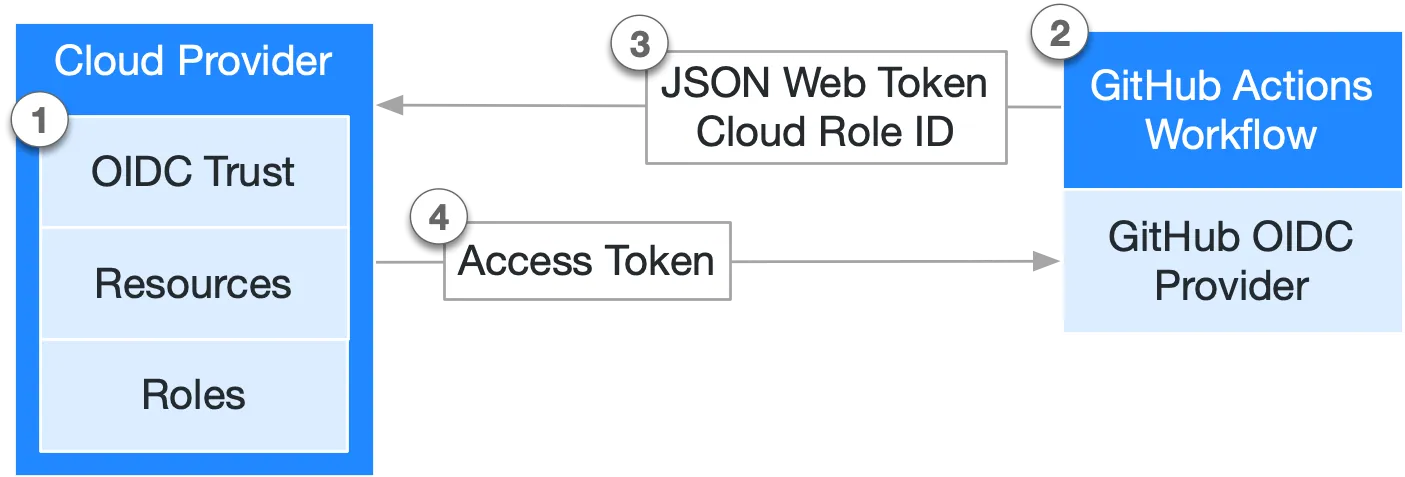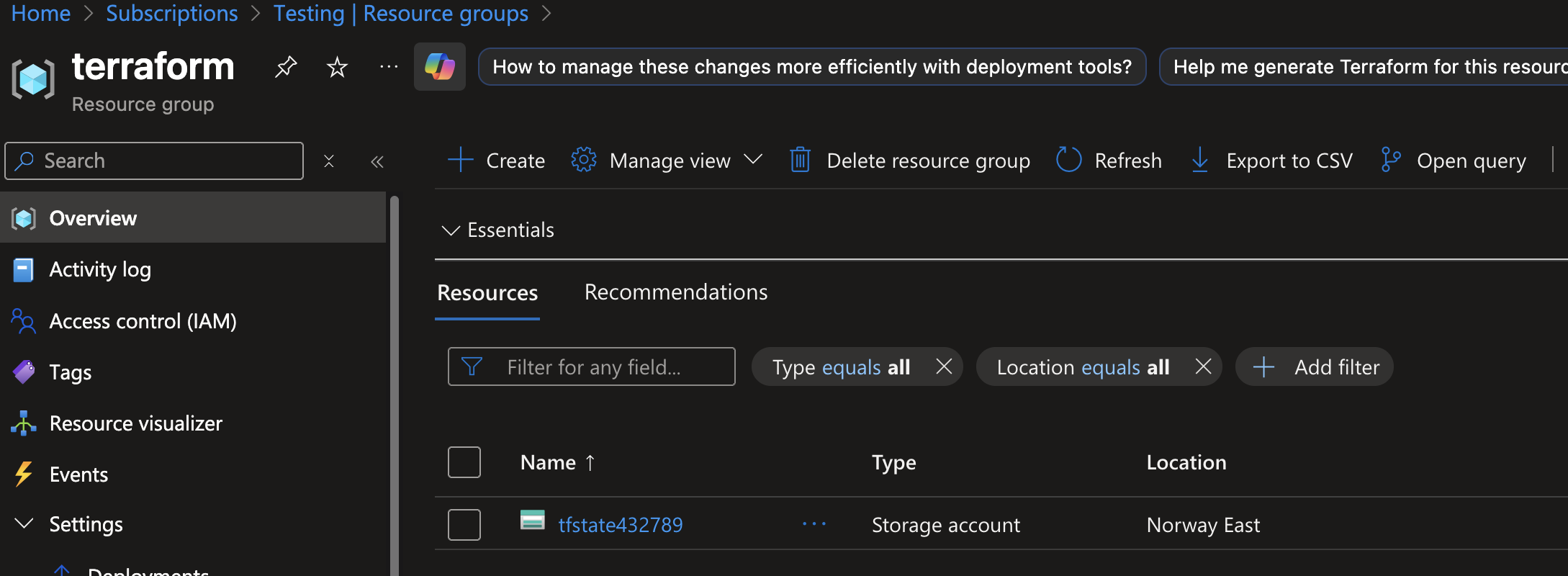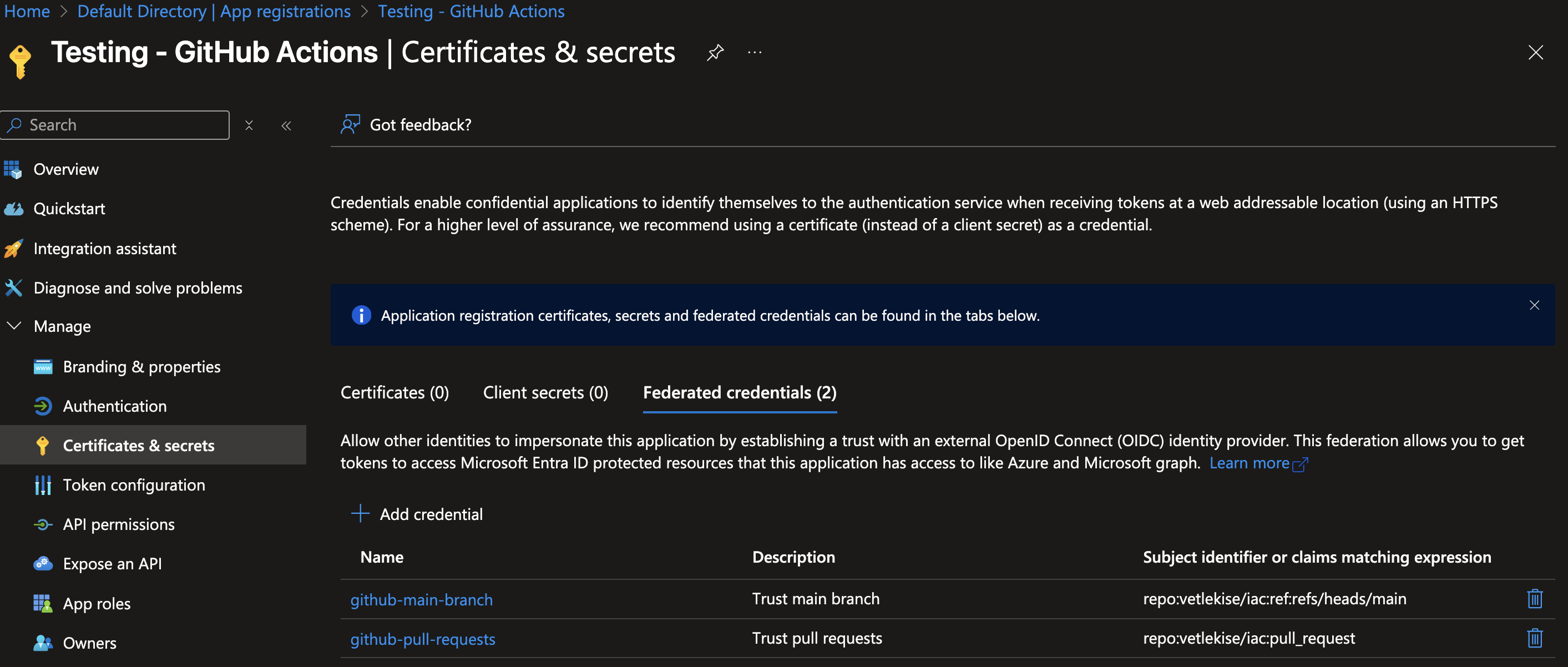What is OIDC?
OIDC stands for OpenID Connect. It’s an identity layer built on top of the OAuth 2.0 framework.
In simple terms, it allows one application (like a GitHub Actions workflow) to securely prove its identity to another application (like a cloud provider such as Azure) without using static, long-lived secrets. Instead, the system uses a short-lived, verifiable ID Token. This process of exchanging a temporary token is often called a “federated identity” workflow and is a much more secure way to manage authentication for automated processes.

Prerequisites
Before you begin, ensure you have the following.
- A GitHub repository must already be created.
- An Microsoft account with an active Azure Subscription. Make sure the account has the Entra ID role
Application Administrator, and Azure Owner role assigned to the subscription. In addition, the subscription needs the Microsoft.Storage resource provider registered.
- Locally installed tools: Git, Azure CLI, and a code editor.
Azure Resources
First, we need to create a few Azure resources, specifically a Resource Group containing a Storage Account. This will store our Terraform state file securely and offer state locking. The below Azure CLI script will create these resources for us, you just need to provide some values first by exporting them as environment variables.
1
2
3
4
|
export RESOURCE_GROUP_NAME="terraform"
export STORAGE_ACCOUNT_NAME="tfstate<INSERT RANDOM NUMBERS>"
export CONTAINER_NAME="tfstate"
export LOCATION=""
|
Now run the below script. When you’re prompted for login, use the Azure account that has permissions to create resources in your desired Subscription.
1
2
3
4
5
6
7
|
az login
az group create --name $RESOURCE_GROUP_NAME --location $LOCATION
az storage account create --name $STORAGE_ACCOUNT_NAME --resource-group $RESOURCE_GROUP_NAME --sku Standard_LRS --encryption-services blob
az storage container create --name $CONTAINER_NAME --account-name $STORAGE_ACCOUNT_NAME
|
You should now have something like this in your Subscription:

Service Principal
For the pipeline to authenticate, we need to create a Service Principal in Entra ID. The below script creates this for us, in addition to that, it creates the federated tokens needed for GitHub Actions to authenticate to Azure, and it also creates a couple of RBAC assignments needed for Terraform to manage the state file and create resources. Before running, export these environment variables:
1
2
3
|
export APP_NAME="GitHub Actions - OIDC"
export YOUR_GITHUB_ORG=""
export YOUR_REPO_NAME=""
|
Now run the below script. You should already be logged in from the previous script, if not, add az login.
1
2
3
4
5
6
7
8
9
10
11
12
13
14
15
16
17
18
19
20
21
22
23
24
25
26
27
28
29
30
31
32
|
AZURE_SUBSCRIPTION_ID=$(az account show --query id -o tsv)
AZURE_CLIENT_ID=$(az ad app create --display-name "$APP_NAME" --query appId -o tsv)
az ad sp create --id $AZURE_CLIENT_ID
az role assignment create \
--role "Contributor" \
--assignee-object-id $(az ad sp show --id $AZURE_CLIENT_ID --query id -o tsv) \
--assignee-principal-type ServicePrincipal \
--scope "/subscriptions/$AZURE_SUBSCRIPTION_ID"
az role assignment create \
--role "Storage Blob Data Contributor" \
--assignee-object-id $(az ad sp show --id $AZURE_CLIENT_ID --query id -o tsv) \
--assignee-principal-type ServicePrincipal \
--scope "/subscriptions/$AZURE_SUBSCRIPTION_ID/resourceGroups/$RESOURCE_GROUP_NAME/providers/Microsoft.Storage/storageAccounts/$STORAGE_ACCOUNT_NAME"
az ad app federated-credential create \
--id $AZURE_CLIENT_ID \
--parameters '{"name":"github-main-branch","issuer":"https://token.actions.githubusercontent.com","subject":"repo:'$YOUR_GITHUB_ORG'/'$YOUR_REPO_NAME':ref:refs/heads/main","description":"Trust main branch","audiences":["api://AzureADTokenExchange"]}'
az ad app federated-credential create \
--id $AZURE_CLIENT_ID \
--parameters '{"name":"github-pull-requests","issuer":"https://token.actions.githubusercontent.com","subject":"repo:'$YOUR_GITHUB_ORG'/'$YOUR_REPO_NAME':pull_request","description":"Trust pull requests","audiences":["api://AzureADTokenExchange"]}'
echo "ARM_CLIENT_ID: $AZURE_CLIENT_ID"
echo "ARM_TENANT_ID: $(az account show --query tenantId -o tsv)"
echo "ARM_SUBSCRIPTION_ID: $AZURE_SUBSCRIPTION_ID"
echo "RESOURCE_GROUP_NAME: $RESOURCE_GROUP_NAME"
echo "STORAGE_ACCOUNT_NAME: $STORAGE_ACCOUNT_NAME"
echo "CONTAINER_NAME: $CONTAINER_NAME"
echo "KEY: terraform.tfstate"
|
Save the echo’d values after the script is finished! These will be used in the next step to configure the Terraform backend.

You should now have a service principal with these two tokens. One for authenticating in a pull request to main and another for pushing to main.

For the azurerm provider to work with OIDC, we need to change some settings and add some variables.
- In your repository, create a Terraform configuration file, for example
versions.tf.
- Open the newly created file and paste in the below code block. Notice the provider settings,
use_oidc and use_azuread_auth. These must be set to true for our pipeline to authenticate.
- Input the missing variables in
backend "azurerm" using the values from the previous script.
1
2
3
4
5
6
7
8
9
10
11
12
13
14
15
16
17
18
19
20
21
|
terraform {
required_providers {
azurerm = {
source = "hashicorp/azurerm"
version = "~>4.0"
}
}
backend "azurerm" {
use_oidc = true
use_azuread_auth = true
resource_group_name = ""
storage_account_name = ""
container_name = ""
key = ""
}
}
provider "azurerm" {
features {}
}
|
GitHub Actions Workflow
In this next step, we are going to create the workflow used by GitHub Actions to deploy our Terraform resources.
- In your repository, create a new directory and file called
.github/workflows/terraform.yml. This file will contain our pipeline.
- Open the newly created file and paste in the below code block. This workflow is built with some best practices in mind. The
plan job runs on Pull Requests to main, uploads the plan binary as an artifact, and creates a comment in your PR with the plan changes. The apply job runs on Push to main, downloads the plan binary from the artifact, and pushes your changes.
- For the pipeline to work properly, edit the
env values using the output from the previous script.
1
2
3
4
5
6
7
8
9
10
11
12
13
14
15
16
17
18
19
20
21
22
23
24
25
26
27
28
29
30
31
32
33
34
35
36
37
38
39
40
41
42
43
44
45
46
47
48
49
50
51
52
53
54
55
56
57
58
59
60
61
62
63
64
65
66
67
68
69
70
71
72
73
74
75
76
77
78
79
80
81
82
83
84
85
86
87
88
89
90
91
92
93
94
95
96
97
98
99
100
101
102
103
104
105
106
107
108
109
110
111
112
113
114
115
116
117
118
119
120
121
122
123
124
125
|
name: 'Terraform OIDC'
on:
# Trigger on pull requests targeting the main branch
pull_request:
types: ["opened", "synchronize", "reopened"]
branches: ["main"]
paths: ["terraform_oidc/**.tf"]
# Trigger on pushes (merges) to the main branch
push:
branches: ["main"]
paths: ["terraform_oidc/**.tf"]
env:
ARM_CLIENT_ID: ""
ARM_SUBSCRIPTION_ID: ""
ARM_TENANT_ID: ""
# Required for OIDC login and for posting PR comments
permissions:
id-token: write
contents: read
pull-requests: write
jobs:
plan:
name: 'Terraform Plan'
runs-on: ubuntu-latest
if: >-
(github.event_name == 'pull_request')
||
(github.event_name == 'push' && github.ref == 'refs/heads/main')
steps:
- name: Checkout
uses: actions/checkout@v5
- name: Azure Login
uses: azure/login@v2
with:
client-id: ${{ env.ARM_CLIENT_ID }}
tenant-id: ${{ env.ARM_TENANT_ID }}
subscription-id: ${{ env.ARM_SUBSCRIPTION_ID }}
- name: Setup Terraform
uses: hashicorp/setup-terraform@v3
- name: Terraform Init
run: terraform init
- name: Terraform Validate
run: terraform validate -no-color
- name: Terraform Plan
id: plan
run: terraform plan -no-color -out="tfplan"
continue-on-error: true
- name: Post Plan Comment to PR
if: github.event_name == 'pull_request'
uses: actions/github-script@v8
env:
PLAN: "terraform\n${{ steps.plan.outputs.stdout }}"
with:
script: |
const { PLAN } = process.env;
const output = `#### Terraform Plan 📖\`${{ github.event.pull_request.head.sha }}\`
<details><summary>Show Plan</summary>
\`\`\`\n${PLAN}\n\`\`\`
</details>
*Pushed by: @${{ github.actor }}, Action: \`${{ github.event_name }}\`*`;
await github.rest.issues.createComment({
owner: context.repo.owner,
repo: context.repo.repo,
issue_number: context.issue.number,
body: output
});
if ("${{ steps.plan.outcome }}" == "failure") {
process.exit(1);
}
- name: Upload Terraform Plan Artifact
if: steps.plan.outcome == 'success'
uses: actions/upload-artifact@v4
with:
name: terraform-plan
path: tfplan
retention-days: 1
apply:
name: 'Terraform Apply'
needs: plan
runs-on: ubuntu-latest
if: github.event_name == 'push' && github.ref == 'refs/heads/main' && needs.Plan.result == 'success'
steps:
- name: Checkout
uses: actions/checkout@v5
- name: Azure Login
uses: azure/login@v2
with:
client-id: ${{ env.ARM_CLIENT_ID }}
tenant-id: ${{ env.ARM_TENANT_ID }}
subscription-id: ${{ env.ARM_SUBSCRIPTION_ID }}
- name: Setup Terraform
uses: hashicorp/setup-terraform@v3
- name: Terraform Init
run: terraform init
- name: Download Terraform Plan Artifact
uses: actions/download-artifact@v5
with:
name: terraform-plan
- name: Terraform Apply
run: terraform apply -auto-approve "tfplan"
|
If you’ve followed all the steps, run the pipeline, it should then authenticate to Azure using OIDC, create a plan on PRs, and deploy changes on merges to main.

Resources & Links
For more detailed information on authentication to the Terraform backend in Azure, please refer to the official documentation.




